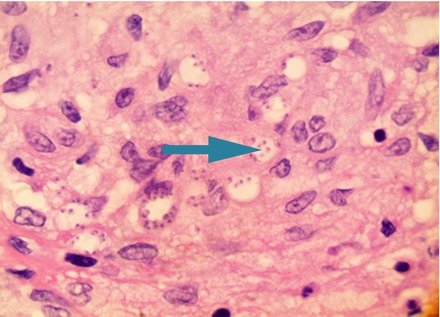Figure 30.1
H&E 100×, Leishmania, a mixed inflammatory infiltrate with scattered multi-nucleated

Figure 30.2
H&E 1,000×, Leishmania, small clusters of organisms between the histiocytes
Diffuse cutaneous leishmania is rare and is caused by L. mexicana and L. aethiopica in certain endemic regions. Unlike localized cutaneous leishmaniasis, these lesions are large and often widespread on the body. They may present as nonulcerating macules, papules, nodules or plaques. Similar to localized cutaneous leishmaniasis, these lesions initially present on exposed surfaces like the face and arms but then disseminated widely over the course of several years.
Muscosal leishmania is a more serious form of leishmaniasis that is usually caused by the Viannia subgenera. This uncommon presentation is caused by hematogenous spread from a cutaneous lesion to the nasopharyngeal mucosa. In the majority of cases, it occurs in individuals who have had a cutaneous lesion within the previous 2 years. However, there are reports of it occurring years after the primary lesion had resolved. Those affected tend to suffer from nasal congestion, epistaxis, and edema. If left untreated, it can cause destruction of the nose and mouth leading to severe disfigurement.
Visceral leishmania, also known as kala-azar, is the most serious clinical form of the disease. In the New World and the Mediterranean regions children less than 5 years old are most commonly affected and L. infantum and L. chagasi are responsible. In Africa and Asia older children and adults are more likely to be infected and the causative organism is L. donovani. Approximately 25 % of the infected individuals will develop the characteristic symptoms of hepatosplenomegaly, high fever, and cachexia within 6 months of contracting the disease. If the individual is untreated, the disease progresses with pancytopenia and severe anemia that may lead to heart failure. Ultimately, the cause of death is a result of secondary bacterial infection and occurs in more than 90 % of the untreated population.
Stay updated, free articles. Join our Telegram channel

Full access? Get Clinical Tree








